Forty three years have passed since Smt Indira Gandhi informed the nation in the morning of June 26, 1975 that “The President has proclaimed an Emergency. This is nothing to panic about.” However, what followed in the next 21 months was a story of vengeance against the political opposition, curtailing of freedom and rights, atrocities by design, targeting by will and imposition of one-leader’s will! It is significant to understand that a history of events like Emergency which came as ruination of democracy cannot be told only through the political leaders. We, the people, have to take the centre-stage in the narrative! The present generation must not be fooled by those who compare a passage of time to Emergency. What really was Emergency and who were those who struggled hard to safeguard democracy for the future generations? The question can only be answered by digging out those facts and names which have been brushed aside by those forces that proclaimed and supported Emergency! Jai Prakash Narayan as the leader and RSS as “We, the people”, stood between the dictatorship and democracy
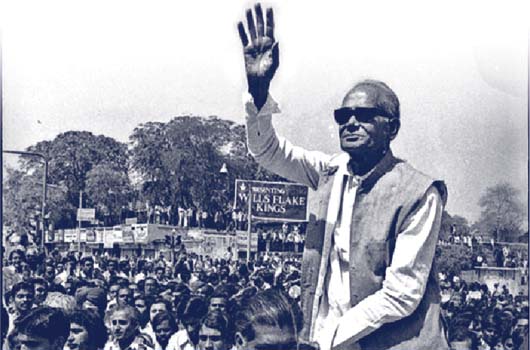
A comprehensive contemporary history of the event and political processes of this period of 21 months is still to be written. Thought there are books by journalists such as Kuldeep Nayar and Coomi Kapoor, academic history writings by Bipan Chandra and Ramchandra Guha and many memoirs and autobiographies, they all share the same limitation. These accounts are often personalised. They are more interested in the causes and consequences. They don’t trace out the history of those 21 months in detail, especially from the vantage point of people’s history. Especially the role played by an organisation like the Rashtriya Swayamsevak Sangh (RSS) tends to get neglected and many times consciously erased.
The third RSS Sarsanghchalak Balasaheb Deoras aptly summarised the role RSS played in this struggle against Emergency. He remarked that, “One man Jai Prakash and the RSS stood between the dictatorship and democracy”. The exemplary courage displayed by, and heroic role the RSS swayamsevaks played in this ‘battle of nerves,’ as Balasaheb Deoras used to say, deserves better mention in the literature on Emergency. Sangh doesn’t get those mentions because of the prejudiced nature of chroniclers. Let us try to understand why?
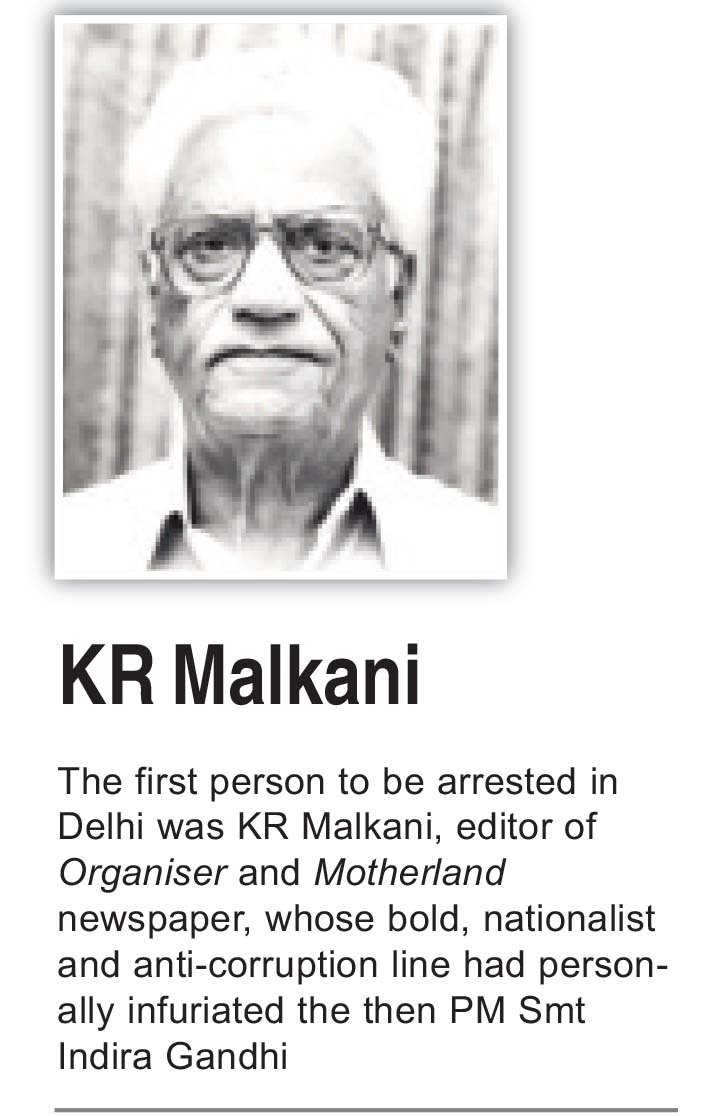
The Freedom Fighters
On December 12 1976, amidst the on-going Emergency in the country, well-known international magazine The Economist wrote, “The underground campaign against Mrs Gandhi claims to be the only non-left wing revolutionary force in the world, disavowing both bloodshed and class struggle. Indeed, it might even be called right wing since it is dominated by the Hindu communalist party, Jan Sangh and its ‘cultural’ (some say paramilitary) affiliate the RSS. But its platform at the moment has only one non-ideological plank; to bring democracy back to India.”
Even if one magnifies levels like ‘right wing’ and ‘Hindu communalist party’, one cannot ignore and belittle the fact that a prominent international news magazine reported that RSS was working ‘to bring democracy back to India’.
According to The People Versus Emergency: A saga of Struggle (1991) the number of RSS swayamsevaks detained under Maintenance of Internal Security Act (MISA) was 23,015 including 22,938 male and 77 female activists. The number of RSS activists arrested for offering satyagraha during Emergency was 44,965 while only 9,655 people of other parties offered satyagraha.
These sacrifices were not just for the sake of activism! It was the “second freedom struggle” for the Sangh. The organisation never profiled itself as some distinct entity but it was a manifestation of people’s power and their struggle in safeguarding the democracy. It was not a coincidence that RSS decided not to avail any benefits offered to its Swayamsevaks, especially the Pracharaks, detained under MISA during Emergency by the Government.
The main target of Smt Indira Gandhi was RSS because she believed that it was the Sangh that provided all the logistic support to the movement launched by Jai Prakash Narayan in Bihar and Gujarat. Therefore, even before Emergency was declared, she was planning to ban it. In January 1975, Siddharth Shankar Ray had prepared a draft to ban RSS and sent that to Smt Gandhi. But somehow that was leaked to the media and the plan was postponed. The Emergency was then used to crush the RSS. Coomi Kapoor’s The Emergency: A Personal History (2015) also brings up this fact that list of those who were to be arrested after the proclamation of Emergency was being prepared for the last six months in 1975. The first person to be arrested in Delhi KR Malkani, editor of Organiser and Motherland newspaper, whose bold, sometimes sensational reports and stridently anti-Gandhi and pro-nationalist line had personally infuriated the PM. Soon after the Emergency was declared, large number of RSS leaders and cadres were arrested. Balasaheb Devras was arrested at Nagpur railway station and incarcerated in Yerwada Jail near Pune.
However, the capacity and strength of RSS can be gauged from the confession of Smt Gandhi. In spite of all the efforts to suppress the Sangh, Smt Gandhi had to admit, “We were not able to capture even 10 per cent of the RSS workers. They all have gone underground and the RSS did not disperse even after the ban, on the contrary it was striking roots in new areas like Kerala”. (The People Versus Emergency: A Saga of Struggle, p. 21)
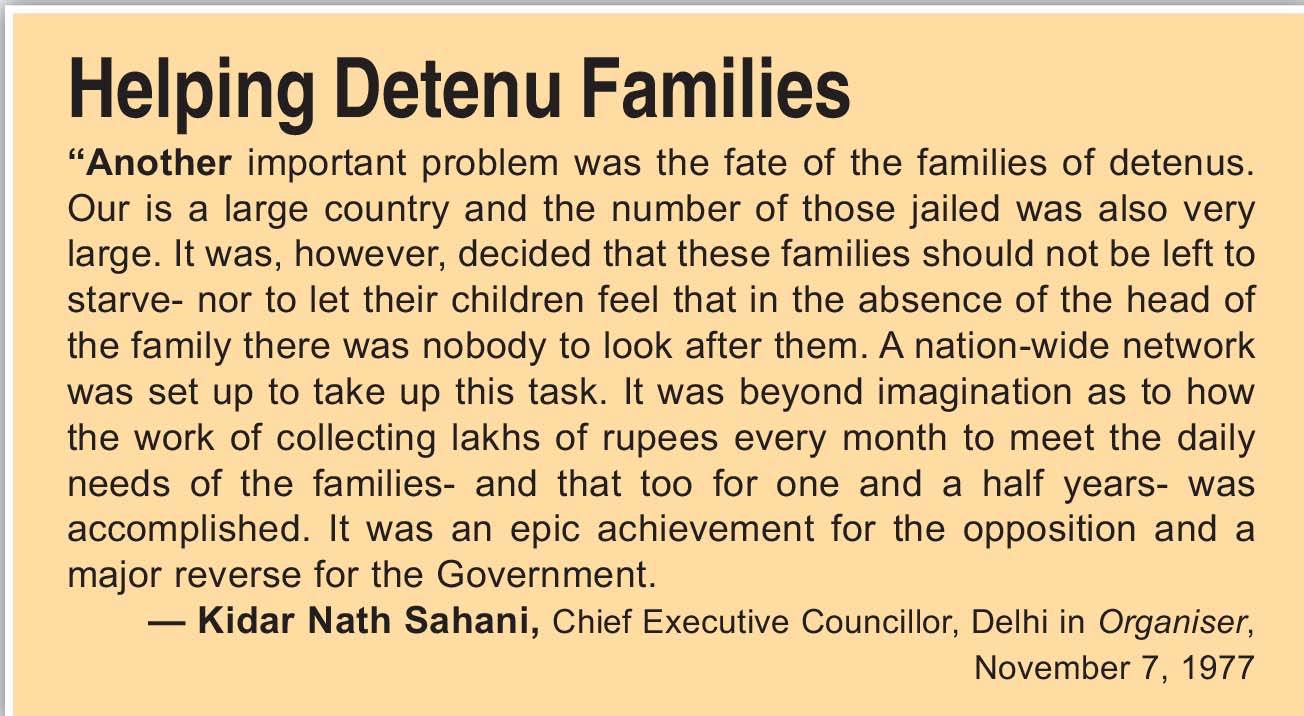
The Gandhian RSS
With the proclamation of Emergency, opposition leaders were arrested, censorship was imposed, and a ban was soon announced on grassroots organisations, including the RSS and 13 of its cover organisations
The RSS chose to defy the ban and offered satyagraha. It was a great irony that those who claimed their inheritance from Gandhi and his values openly defiled them while the Sangh that was accused of violence successfully adhered to the Gandhian way.
Sangh launched a stayagraha from Novemebr 14, 1975 to January 14, 1976 demanding removal of Emergency and restoration of democracy; lifting press censorship; releasing all the arrested leaders and lifting the ban on RSS. The response to RSS satyagraha was tremendous. Over 1.5 lakh people offered satyagraha at some 5,349 places. Thousands were arrested while 87 swayasmevaks were martyred during the Emergency. Sangh proved that it was the only Gandhian organisation in the country by following the Gandhian way!
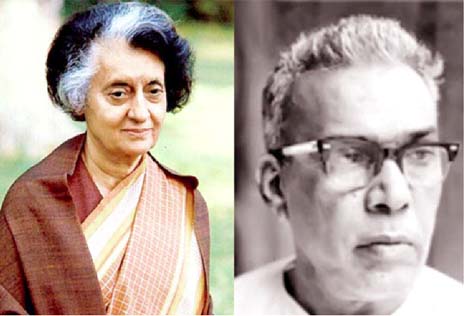
Shri Balasaheb Deoras maintained dialogue with Smt Gandhi
The Gandhian design was not only restricted to offering satyagraha. Balasaheb Deoras also wrote letters from the Yervada Jail to PM Indira Gandhi, Maharashtra CM SB Chavan and to Vinoba Bhave. In the spirit of dialogue he continuously engaged with Smt Gandhi and also pleaded for the release of RSS detenues and the lifting the ban on Sangh. In a letter written on July 16, 1976, he also congratulated Smt Gandhi for her efforts ‘to improve relations with Pakistan and China’. However, these deliberations have been misinterpreted by Marxists like AG Noorani to doubt the credentials of struggle and anti-Emergency stand of the Sangh.
When Indira Gandhi finally announced the elections in 1977, she knew well that the RSS was the only force that could quickly reassemble and help the Janata Party to victory. Therefore, she approached Shri Deoras with an olive branch to withdraw the ban on the RSS if it did not support the Janata Party. But Deoras firmly declined, and the rest is history. However, after the Emergency, when YB Chavan appealed for “Forget and Forgive”, Shri Deoras was the first to back him, saying that an atmosphere of vindictiveness was detrimental to the nation, despite the fact that the RSS swayamsevaks had suffered the most during the Emergency.
Once, Prof Rajendra Singh alias Rajju Bhaiya (who succeeded Balasaheb Deoras as the fourth Sarsanghchalak) accompanied Balasaheb Deoras on a visit to the then Home Minister Chaudhary Charan Singh in the Janta Party Government. Balasaheb Deoras had been promoting the line of “Forget and Forgive” and he also appealed for the same to the Home Minister. However, Chaudhary Charan Singh declined the request stating that as a Home Minister it is his duty to bring Smt Gandhi to the book for the atrocities committed by her. (Hamare Rajju Bhaiya, 2015, pp. 158-59)
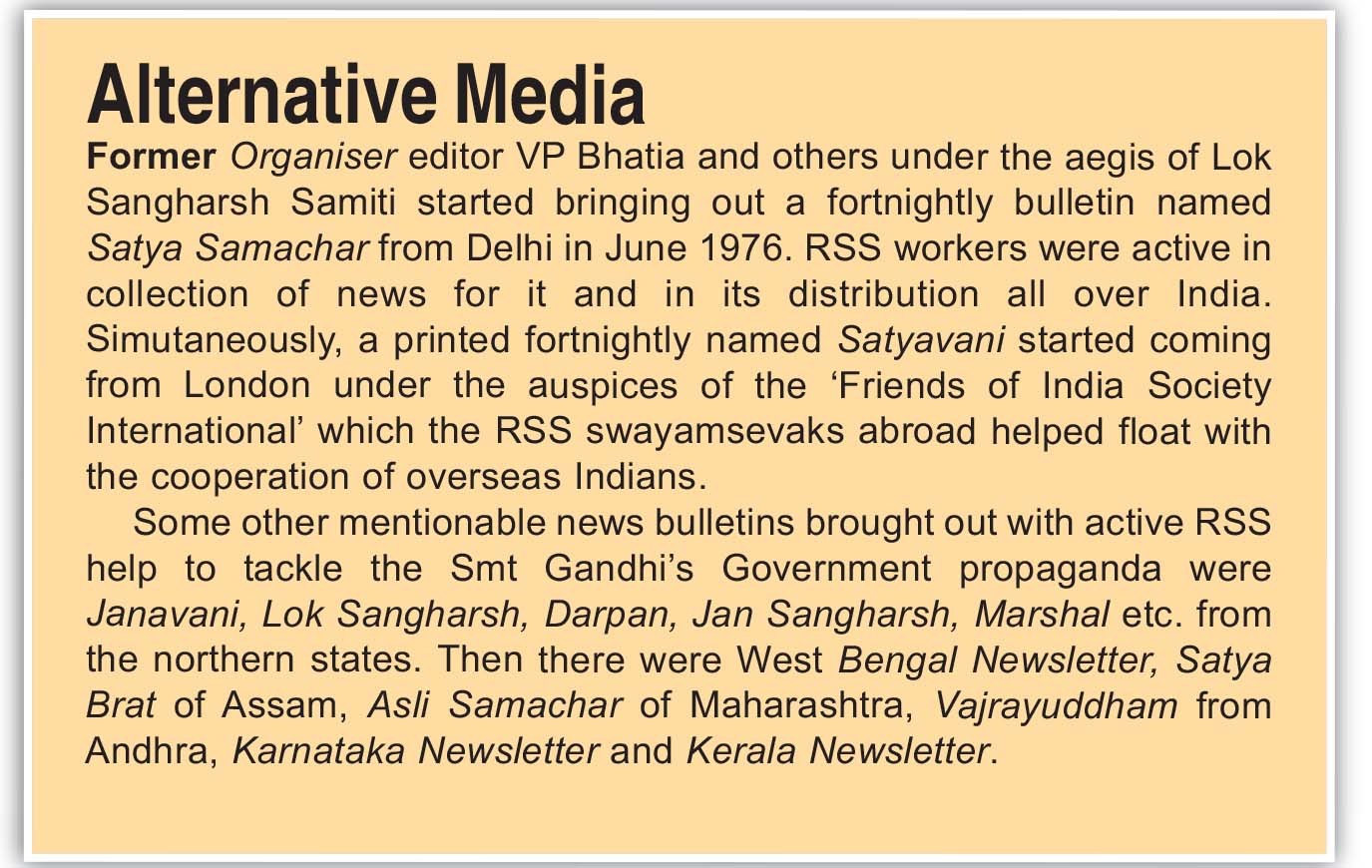
Misinformation against Sangh
The great role played by RSS has been diminished and in fact, expunged by its political and ideological adversaries. Former Intelligence Bureau (IB) chief TV Rajeswar has claimed that the RSS had supported several measures taken during the Emergency and the then chief of the organisation Balasaheb Deoras had tried to contact then PM Indira Gandhi. Other Marxists like AG Noorani and Bipan Chandra have also labelled RSS as a Fascist organisation. Most of these claims are based on the same set of letters which Balasaheb Deoras wrote to Smt Gandhi in the Gandhian spirit of dialogue.
In fact, a historian like Bipan Chandra goes to the extent of almost unfairly criticising the whole JP Movement because it took the aid of swayamsevaks. In his book, In the Name of Democracy (Penguin, 2003), Chandra has squared his criticism regarding the JP Movement solely for one reason that JP sided with the Sangh.
However, accounts of Emergency, such as, Apatkaleen Mein Sangharsh Gatha (1978), translated into English in 1991; contain numerous anecdotes about covert encounters between underground activists, and literature circulated to take on the authoritarian designs of Smt Gandhi by the swayamsevaks. But, for historians like Bipan Chandra, their labelling of Sangh as Fascist was enough to not probe these source materials and write the accounts of Sangh’s struggle on the ground.
Who was better than JP himself to know that which organisation worked the best to safeguard the democracy of the country? On November 3, 1977, after Emergency was lifted, JP addressed Sangh swayamsevaks in a camp. He praised the Sangh as a “revolutionary organisation, there is no other organisation in the country which can match you.” JP was aware of the historical campaign of misinformation against RSS since the days of Jawaharlal Nehru and he declared in front of thousands of swayamsevaks that “If you are fascist, then I too am a fascist.”
Indeed, Emergency was the “second freedom struggle” and Sangh as a society and people played its crucial role in leading the struggle and achieving success in the same.


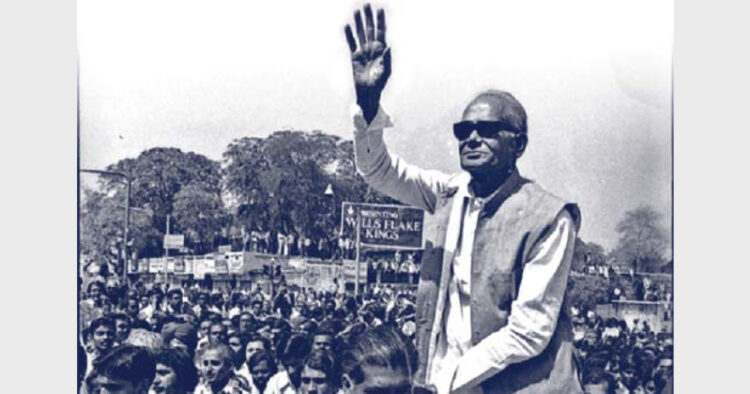










Comments